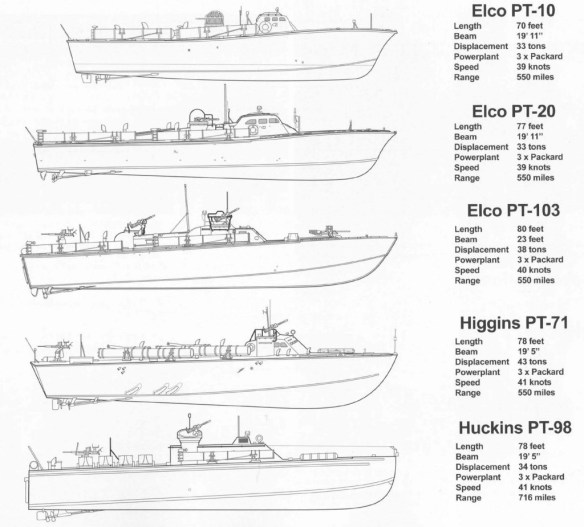
Known popularly as PT boats, World War II–era patrol-torpedo boats were the American equivalent of German E boats and British motor torpedo boats. They were small, fast, wooden-hulled, shallow-draft vessels that depended on surprise, speed, and maneuverability and thus did their best work in coastal waters.
During World War I, the Italian navy built and used some 299 torpedo-armed motorboats against the Austro- Hungarian navy in the Adriatic. From 1916, the British navy used coastal motor boats in home waters and in the raids against Ostend and Zeebrugge, Belgium, in April 1918. Although the United States did not use such craft in World War I, the Electric Boat Company’s Elco Division in Bayonne, New Jersey, constructed several hundred power boats for Britain and Italy and gained expertise in designing and manufacturing that type of vessel.
In the late 1930s, the U.S. Navy was pushed toward the development of gasoline-powered motor boats by President Franklin D. Roosevelt and Assistant Secretary of the Navy Charles Edison, both of whom were concerned about European interest in these craft. They secured a 1938 appropriation of $5 million for the construction of ships of fewer than 3,000 tons displacement. In June, the navy staged an American design competition, selecting seven winners for further testing, but Edison decided instead to put into limited production at Elco a 70 ft craft, with a crew of 10 men, from the British designer Hubert Scott- Paine. Elco’s boat substituted Packard engines for those of Rolls-Royce. By 1941, Elco had progressed to a 77 ft version that demonstrated an average speed of 27.5 knots in rough waters and mounted 2 ÷ 21-in. torpedo tubes and 2 ÷ 50-caliber machine guns in twin turrets. The boats also had the ability to lay smokescreens. Andrew Jackson Higgins, a Louisiana shipbuilder, developed a similar 78 ft vessel. At 80 ft or less, the boats could be carried on long voyages by larger ships.
During World War II, the United States deployed in the Pacific 350 PT boats, mostly of the Elco and Higgins types, along with 42 in the Mediterranean and 33 in the English Channel. Together, they launched in combat a total of only 697 torpedoes, usually with minimal success. All too often, American torpedoes were defective, and firing them accurately from fast-moving vessels was problematic in any case. Nor were PT boats fortunate at antisubmarine warfare, being much too noisy to make effective use of sonar equipment. The most memorable action in European waters by this type of craft came from the Germans when they sent their E boats in an attack on an American landing exercise at Slapton Sands, England, on 18 April 1944. The Germans sank two LSTs (landing ships, tank), damaged a third, and killed more than 700 Americans.
In the South and Southwest Pacific Theaters, the most profitable service of American PT boats was in coastal work. Their speed made them difficult targets for shore batteries. With a 40 mm gun and, perhaps, 4.5-inch barrage rockets or mortars replacing their torpedoes, they could attack Japanese landing barges (daihatsus), which, as the war progressed, were typically used to deliver reinforcements to forward positions. In one five-month period off New Guinea, PT boats claimed some 115 barges sunk with minimal losses of their own.
Two PT boat events, because of the personalities involved, overshadowed all others in the war. The first, in the Philippines in the early weeks of the conflict, involved Motor Torpedo Boat Squadron 3 under Lieutenant John D. Bulkeley. He and his men displayed great gallantry in various actions but achieved limited success against Japanese invading forces. Then, in March 1942, theater commander General Douglas MacArthur, under orders to leave the Philippines for Australia, selected Bulkeley and his four available boats to convey his party of 22 persons—including his wife, young son, housekeeper, and key staff members—more than 500 miles from Corregidor Island in Manila Bay through the Japanese blockade southward to Mindanao, from where MacArthur could complete the trip by air. At great risk, the journey was completed between 11 and 13 March. MacArthur could have traveled much more easily and safely in a submarine but seemed to have been unwilling to be confined beneath the waves at such close quarters. As it was, his escape from Corregidor—and the PT boats’ role in it—proved to be the stuff of legend and were recounted in W. H. White’s 1942 book They Were Expendable and John Ford’s 1945 film of the same name.
The second incident involved a confused night action. In Blackett Strait off Kolombangara in the Solomon Islands on 1 August 1943, Lieutenant John F. Kennedy’s PT-109 was struck and sunk by the Japanese destroyer Amagiri. Kennedy and other survivors then swam to a nearby Japanese-held island, from which they were rescued after several days. Although written up in the New Yorker magazine by John Hersey during the war, the incident became widely known only after Kennedy launched his successful run for the presidency in 1960. By 1963, Kennedy’s experiences had inspired several books, the film PT 109, and (at least indirectly) the television comedy series “McHale’s Navy.”
Overall, the PT boat proved a serviceable but not decisive weapon. The successors of such craft were later employed in riverine operations during the Vietnam War.
References Bulkley, Robert J., Jr. At Close Quarters: PT Boats in the United States Navy. Washington, DC: Naval Historical Division, 1962. Donovan, Robert J. PT 109: John F. Kennedy in World War II. New York: McGraw-Hill, 1961. Morison, Samuel Eliot. History of U.S. Naval Operations in World War II. 15 vols. Boston: Little, Brown, 1947–1962. Nelson, Curtis L. Hunters in the Shallows: A History of the PT Boat. Washington, DC: Brassey’s, 1998. Strahan, Jerry E. Andrew Jackson Higgins and the Boats That Won World War II. Baton Rouge: Louisiana State University Press, 1994.